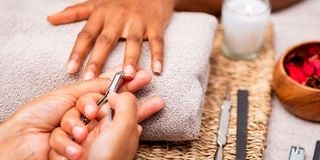Show your cuticles some love

Well taken care of nails go a long way towards making a woman appear younger.
Hands can be quite the betrayers. It's believed they are the one thing that discloses a woman’s real age. From liver spots, sun damage to wrinkles, age gets more visible on the back of your hands as time goes by. This is probably why manicures are a go-to for older women. Well taken care of nails go a long way towards making a woman appear younger.
One of the things that a manicure does is take care of your cuticles. Cuticles are the bottom part of your nail bed where the nail meets the skin. Handling cuticles is the one thing that will give your manicure a salon-inspired manicure. But, there are a lot of thoughts when it comes to cuticles.
To cut or not to cut? Depends on who you ask. Both the Mayo Clinic and the American Association of Dermatologists say no — do not even think about it. It doesn’t matter whether you do this at home or at the salon. Just. Don’t. Their reasoning is quite simple really. Cuticles have one critical job. They protect the skin surrounding them, and your nails, from infection. Once you cut them off, an infection gets a stronger breeding ground.
Here is the problem. Most salons still trim cuticles despite this debate, believing it to make a manicure and pedicure look salon-ready. If you are a stubborn mule and want to keep trimming your cuticles no matter what the expert says, then it is a good idea to do it safely. The problem is, no one seems to agree on how to do this either.
According to Mind. Body. Green (MBG), you should not soak your nails in water, and need to trim your cuticles when your nail bed and hands are dry. And, MBG says the cuticle is actually a layer of clear dead skin that hangs around the nail plate. They are still on the fence on this one, not sure if they should be trimmed, or not.
Brittle
They do agree, however, that you need to let professionals do their job, and to wait until your next salon visit to trim the cuticles. Water expands your nails, causing them to contract, which makes them brittle. An alternative would be to soak them, then push them back, and trim that bit of skin.
According to healthline.com, you need to soak your hands in warm soapy water for an average of 15 minutes to soften them, at which point you can then trim the cuticles. An alternative is to do the trimming straight out of the shower. Do not cut around the nail plate.
If you want pretty cuticles, then massage cuticle oil into them every night before you go to bed. Or, every time you wash your hands depending on the state of your cuticles. Compound this with healthy nail supplements that contain keratin amino acids to keep your nails and cuticles strong.
You can also get an orange stick or cotton buds, wet them, and push back your cuticles. If you can’t differentiate your cuticles from a hole in the ground, leave it at that. Your cuticles are bound to be in a dehydrated state if you use 100 per cent acetone to soak your artificial nails or have an acetone-based nail polish remover. Incidentally, do not confuse cuticles with hangnails. Hangnails are on the sides of your nails and can sometimes become dry, scratching fabric and surfaces.
Use cuticle oil on these too. By the way, infected cuticles have a redness around the skin of the nail, feels tender to the touch, may develop pus blisters, and could even result in nail detachment. Another way to protect your cuticles is to use rubber gloves when doing chores involving water and to apply sunscreen to your hands.
Keep hand cream close by so that after every hand wash and sanitisation, you moisturise your hands. Your hands are an ecosystem all on its own. Whatever you do to keep your hands healthy will also keep your cuticles healthy.





